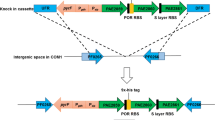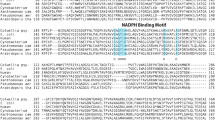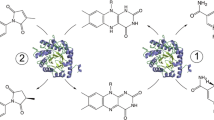Abstract
The endogenous components of the thioredoxin system in the Antarctic eubacterium Pseudoalteromonas haloplanktis have been purified and characterised. The temperature dependence of the activities sustained by thioredoxin (PhTrx) and thioredoxin reductase (PhTrxR) pointed to their adaptation in the cold growth environment. PhTrxR was purified as a flavoenzyme and its activity was significantly enhanced in the presence of molar concentration of monovalent cations. The energetics of the partial reactions leading to the whole electron transfer from NADPH to the target protein substrate in the reconstituted thioredoxin system was also investigated. While the initial electron transfer from NADPH to PhTrxR was energetically favoured, the final passage to the heterologous protein substrate enhanced the energetic barrier of the whole process. The energy of activation of the heat inactivation process essentially reflected the psychrophilic origin of PhTrxR. Vice versa, PhTrx possessed an exceptional heat resistance (half-life, 4.4 h at 95 °C), ranking this protein among the most thermostable enzymes reported so far in psychrophiles. PhTrxR was covalently modified by glutathione, mainly by its oxidised or nitrosylated forms. A mutagenic analysis realised on three non catalytic cysteines of the flavoenzyme allowed the identification of C303 as the target for the S-glutathionylation reaction.








Similar content being viewed by others
Abbreviations
- Ap:
-
Aeropyrum pernix
- Ec :
-
Escherichia coli
- Ph :
-
Pseudoalteromonas haloplanktis
- DTNB:
-
5,5′-dithiobis-2-nitrobenzoic acid
- DTT:
-
Dithiothreitol
- GSH:
-
Reduced glutathione
- GSSG:
-
Oxidised glutathione
- GSNO:
-
Nitrosylated glutathione
- PMSF:
-
Phenylmethanesulphonyl fluoride
- TNB:
-
2-nitro-5-thiobenzoate
- Trx:
-
Thioredoxin
- TrxR:
-
Thioredoxin reductase
- Trx-S2 and Trx-(SH)2 :
-
Oxidised and reduced form of Trx, respectively
- k in :
-
Heat inactivation rate constant
References
Arnér ESJ, Holmgren A (2000) Physiological functions of thioredoxin and thioredoxin reductase. Eur J Biochem 267:6102–6109
Arscott LD, Gromer S, Schirmer RH, Becker K, Williams CH Jr (1997) The mechanism of thioredoxin reductase from human placenta is similar to the mechanisms of lipoamide dehydrogenase and glutathione reductase and is distinct from the mechanism of thioredoxin reductase from Escherichia coli. Proc Natl Acad Sci 94:3621–3626
Birolo L, Tutino ML, Fontanella B, Gerday C, Mainolfi K, Pascarella S, Sannia G, Vinci F, Marino G (2000) Aspartate aminotransferase from the Antarctic bacterium Pseudoalteromonas haloplanktis TAC 125. Cloning, expression, properties, and molecular modelling. Eur J Biochem 267:2790–2802
Bradford M (1976) A rapid and sensitive method for the quantitation of microgram quantities of protein utilizing the principle of protein-dye binding. Anal Biochem 72:248–254
Castellano I, Di Maro A, Ruocco MR, Chambery A, Parente A, Di Martino MT, Parlato G, Masullo M, De Vendittis E (2006) Psychrophilic superoxide dismutase from Pseudoalteromonas haloplanktis: biochemical characterization and identification of a highly reactive cysteine residue. Biochimie 88:1377–1389
Castellano I, Ruocco MR, Cecere F, Di Maro A, Chambery A, Michniewicz A, Parlato G, Masullo M, De Vendittis E (2008) Glutathionylation of the iron superoxide dismutase from the psychrophilic eubacterium Pseudoalteromonas haloplanktis. Biochim Biophys Acta 1784:816–826
Castellano I, Cecere F, De Vendittis A, Cotugno R, Chambery A, Di Maro A, Michniewicz A, Parlato G, Masullo M, Avvedimento EV, De Vendittis E, Ruocco MR (2009) Rat mitochondrial manganese superoxide dismutase: amino acid positions involved in covalent modifications, activity, and heat stability. Biopolymers 91:1215–1226
Chae HZ, Chung SJ, Rhee SG (1994) Thioredoxin-dependent peroxide reductase from yeast. J Biol Chem 269:27670–27678
Clark WM (1960) Oxidation-reduction potentials of organic systems. The Williams & Wilkins Co., Baltimore
Cotugno R, Ruocco MR, Marco S, Falasca P, Evangelista G, Raimo G, Chambery A, Di Maro A, Masullo M, De Vendittis E (2009) Differential cold-adaptation among protein components of the thioredoxin system in the psychrophilic eubacterium Pseudoalteromonas haloplanktis TAC 125. Mol BioSyst 5:519–528
De Vendittis E, Castellano I, Cotugno R, Ruocco MR, Raimo G, Masullo M (2008) Adaptation of model proteins from cold to hot environments involves continuous and small adjustments of average parameters related to amino acid composition. J Theor Biol 250:156–171
De Vendittis A, Amato M, Mickniewicz A, Parlato G, De Angelis A, Castellano I, Rullo R, Riccitiello F, Rengo S, Masullo M, De Vendittis E (2010) Regulation of the properties of superoxide dismutase from the dental pathogenic microorganism Streptococcus mutans by iron- and manganese-bound co-factor. Mol BioSyst 6:1973–1982
Ejiri SI, Weissbach H, Brot N (1979) Reduction of methionine sulfoxide to methionine by Escherichia coli. J Bacteriol 139:161–164
Evangelista G, Falasca P, Ruggiero I, Masullo M, Raimo G (2009) Molecular and functional characterization of polynucleotide phosphorylase from the Antarctic eubacterium Pseudoalteromonas haloplanktis. Protein Pept Lett 16:999–1005
Gasdaska PY, Berggren MM, Berry MJ, Powis G (1999) Cloning, sequencing and functional expression of a novel human thioredoxin reductase. FEBS Lett 442:105–111
Ghisla S, Massey V (1989) Mechanisms of flavoprotein-catalyzed reactions. Eur J Biochem 181:1–17
Gilbert HF (1990) Molecular and cellular aspects of thiol-disulfide exchange. Adv Enzymol Relat Areas Mol Biol 63:69–172
Grimaldi P, Ruocco MR, Lanzotti MA, Ruggiero A, Ruggiero I, Arcari P, Vitagliano L, Masullo M (2008) Characterisation of the components of the thioredoxin system in the archaeon Sulfolobus solfataricus. Extremophiles 12:553–562
Hernandez HH, Jaquez OA, Hamill LJ, Elliot SJ, Drennan CL (2008) Thioredoxin reductase from Thermoplasma acidophilum: a new twist on redox regulation. Biochemistry 47:9728–9737
Hirt RP, Müller S, Embley TM, Coombs GH (2002) The diversity and evolution of thioredoxin reductase: new perspectives. Trends Parasitol 18:302–308
Holmgren A (1979a) Thioredoxin catalyzes the reduction of insulin disulfides by dithiothreitol and dihydrolipoamide. J Biol Chem 254:9627–9632
Holmgren A (1979b) Reduction of disulfides by thioredoxin. Exceptional reactivity of insulin and suggested functions of thioredoxin in mechanism of hormone action. J Biol Chem 254:9113–9119
Holmgren A (1985) Thioredoxin. Annu Rev Biochem 54:237–271
Holmgren A (1989) Thioredoxin and glutaredoxin systems. J Biol Chem 264:13963–13966
Huber HE, Tabor S, Richardson CC (1987) Escherichia coli thioredoxin stabilizes complexes of bacteriophage T7 DNA polymerase and primed templates. J Biol Chem 262:16224–16232
Jeon SJ, Ishikawa K (2002) Identification and characterization of thioredoxin and thioredoxin reductase from Aeropyrum pernix K1. Eur J Biochem 269:5423–5430
Kanzok SM, Fechner A, Bauer H, Ulschmid JK, Müller HM, Botella-Munoz J, Schneuwly S, Schirmer R, Becker K (2001) Substitution of the thioredoxin system for glutathione reductase in Drosophila melanogaster. Science 291:643–646
Kashima Y, Ishikawa K (2003) A hyperthermostable novel protein-disulfide oxidoreductase is reduced by thioredoxin reductase from hyperthermophilic archaeon Pyrococcus horikoshii. Arch Biochem Biophys 418:179–185
Kern R, Malki A, Holmgren A, Richarme G (2003) Chaperone properties of Escherichia coli thioredoxin and thioredoxin reductase. Biochem J 371:965–972
Krause G, Lundstrom J, Barea JL, Pueyo de la Cuesta C, Holmgren A (1991) Mimicking the active site of protein disulfide isomerase by substitution of proline 34 in Escherichia coli thioredoxin. J Biol Chem 266:9494–9500
Ladenstein R, Ren B (2006) Protein disulfides and protein disulfide oxidoreductases in hyperthermophiles. FEBS J 273:4170–4185
Laemmli UK (1970) Cleavage of structural proteins during the assembly of the head of bacteriophage T4. Nature 227:680–685
Lennon BW, Williams CH Jr, Ludwig ML (2000) Twists in catalysis: alternating conformations of Escherichia coli thioredoxin reductase. Science 289:1190–1194
Luthman M, Holmgren A (1982) Rat liver thioredoxin and thioredoxin reductase: purification and characterization. Biochemistry 21:6628–6633
Madonna S, Papa R, Birolo L, Autore F, Doti N, Marino G, Quemeneur E, Sannia G, Tutino ML, Duilio A (2006) The thiol-disulfide oxidoreductase system in the cold-adapted bacterium Pseudoalteromonas haloplanktis TAC 125: discovery of a novel disulfide oxidoreductase enzyme. Extremophiles 10:41–51
Masullo M, Raimo G, Bocchini V (1993) Resistance of archaebacterial aEF-1alpha·GDP against denaturation by heat and urea. Biochim Biophys Acta 1162:35–39
Masullo M, Arcari P, de Paola B, Parmeggiani A, Bocchini V (2000) Psychrophilic elongation factor Tu from the Antarctic Moraxella s. Tac II25: biochemical characterization and cloning of the encoding gene. Biochemistry 39:15531–15539
Matthews JR, Wakasugi N, Virelizier JL, Yodoi J, Hay RT (1992) Thioredoxin regulates the DNA binding activity of NF-kappa B by reduction of a disulphide bond involving cysteine 62. Nucleic Acids Res 20:3821–3830
Medigue C, Krin E, Pascal G, Barbe V, Bernsel A, Bertin PN, Cheung F, Cruveiller S, D’Amico S, Duilio A, Fang G, Feller G, Ho C, Mangenot S, Marino G, Nilsson J, Parrilli E, Rocha EPC, Rouy Z, Sekowska A, Tutino ML, Vallenet D, von Heijne G, Danchin A (2005) Co** with cold: the genome of the versatile marine Antarctica bacterium Pseudoalteromonas haloplanktis TAC125. Genome Res 15:1325–1335
Miranda-Vizuete A, Damdimopoulos AE, Gustafsson J, Spyrou G (1997) Cloning, expression, and characterization of a novel Escherichia coli thioredoxin. J Biol Chem 272:30841–30847
Moore EC, Reichard P, Thelander L (1964) Enzymatic synthesis of deoxyribonucleotides. V. Purification and properties of thioredoxin reductase from Escherichia coli B. J Biol Chem 239:3445–3452
Pörtner HO, Peck L, Somero G (2007) Thermal limits and adaptation in marine Antarctic ectotherms: and integrative view. Phil Trans R Soc B 362:2233–2258
Raimo G, Lombardo B, Masullo M, Lamberti A, Longo O, Arcari P (2004) Elongation factor Ts from the Antarctic eubacterium Pseudoalteromonas haloplanktis TAC 125: biochemical characterization and cloning of the encoding gene. Biochemistry 43:14759–14766
Ruocco MR, Ruggiero A, Masullo L, Arcari P, Masullo M (2004) A 35 kDa NAD(P)H oxidase previously isolated from the archaeon Sulfolobus solfataricus is instead a thioredoxin reductase. Biochimie 86:883–892
Schenk H, Klein M, Erdbrügger W, Dröge W, Schulze-Osthoff K (1994) Distinct effects of thioredoxin and antioxidants on the activation of transcription factors NF-kappa B and AP-1. Proc Natl Acad Sci USA 91:1672–1676
Spyrou G, Enmark E, Miranda-Vizuete A, Gustaffson J (1997) Cloning and expression of a novel mammalian thioredoxin. J Biol Chem 272:2936–2941
Srimathi S, Jayaraman G, Feller G, Danielsson B, Narayanan PR (2007) Intrinsic halotolerance of the psychrophilic α-amylase from Pseudoalteromonas haloplanktis. Extremophiles 11:505–515
Tsang ML, Schiff JA (1976) Sulfate-reducing pathway in Escherichia coli involving bound intermediates. J Bacteriol 125:923–933
Williams CH Jr (1995) Mechanism and structure of thioredoxin reductase from Escherichia coli. FASEB J 9:1267–1276
Windle HJ, Fox A, Ni Eidhin D, Kelleher D (2000) The thioredoxin system of Helicobacter pylori. J Biol Chem 275:5081–5089
Acknowledgments
This work was supported by grants from MIUR, PRIN 2009 (Rome) awarded to MM, EDV, GR.
Author information
Authors and Affiliations
Corresponding authors
Additional information
Communicated by F. Robb.
Authors P. Falasca and G. Evangelista equally contributed to this work.
Rights and permissions
About this article
Cite this article
Falasca, P., Evangelista, G., Cotugno, R. et al. Properties of the endogenous components of the thioredoxin system in the psychrophilic eubacterium Pseudoalteromonas haloplanktis TAC 125. Extremophiles 16, 539–552 (2012). https://doi.org/10.1007/s00792-012-0453-0
Received:
Accepted:
Published:
Issue Date:
DOI: https://doi.org/10.1007/s00792-012-0453-0




